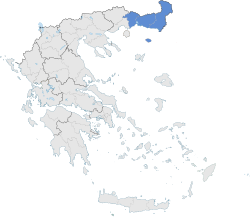Aegean Thrace
|
Thrace Θράκη |
||
|---|---|---|
| Traditional region of Greece | ||
|
||
 Thrace (blue) within Greece |
||
| Annexation by Greece | 1920 | |
| Replaced as administrative region by East Macedonia and Thrace | 1987 | |
| Capital | Komotini | |
| Regional units | ||
| Area | ||
| • Total | 8,578 km2 (3,312 sq mi) | |
| Population | ||
| • Total | 371,208 (2011 census) |
|
| • Density | 43/km2 (110/sq mi) | |
| Demonym(s) | Thracians | |
| Largest City | Alexandroupolis | |
| Website | www |
|
Western Thrace (Greek: [Δυτική] Θράκη, [Dytikí] Thráki, [ˈθraci]; Turkish: Batı Trakya; Bulgarian: Западна Тракия, Zapadna Trakiya or Беломорска Тракия, Belomorska Trakiya) is a geographic and historical region of Greece, between the Nestos and Evros rivers in the northeast of the country; Eastern Thrace, which lies east of the river Evros, forms the European part of Turkey, and the area to the north, in Bulgaria, is known as Northern Thrace.
Inhabited since paleolithic times, it has been under the political, cultural and linguistic influence of the Greek world since the classical era; Greeks from the Aegean islands extensively colonized the region (especially the coastal part) and built prosperous cities such as Abdera (home of Democritus, the 5th-century philosopher who developed an atomic particle theory, and of Protagoras, a leading sophist) and Sale (near present-day Alexandroupoli). Under the Byzantine Empire, Western Thrace benefited from its position close to the imperial heartland and became a center of medieval Greek commerce and culture; later, under the Ottoman Empire, a number of Muslims settled there, marking the birth of the Muslim minority of Greece.
...
Wikipedia

